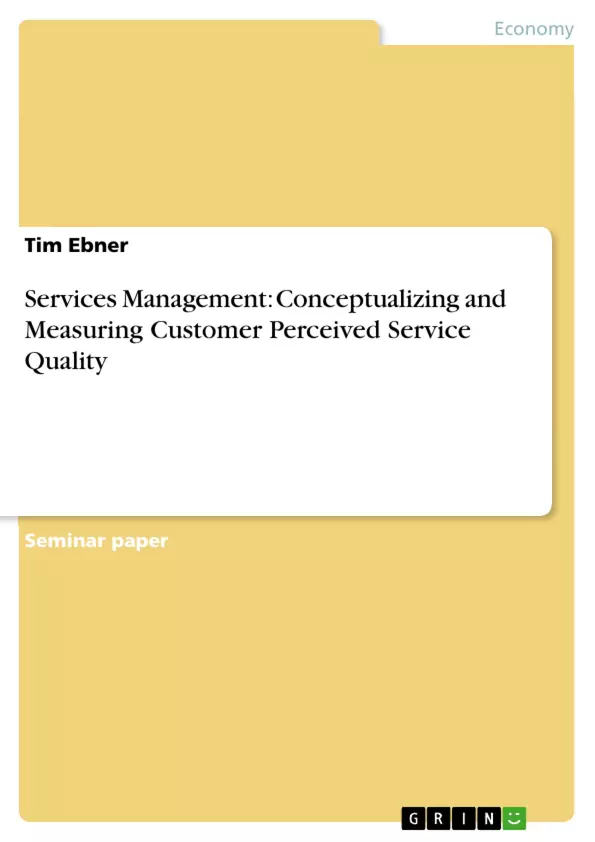Service Quality is a field of marketing, which stimulated numerous scholars to do theoretical and empirical research on. The SERVQUAL concept first was amongst concepts like The Nordic Model by Grönroos (1984) and The Three-Component Model by Rust and Oliver (1994) and SERVPERF by Cronin and Taylor (1992). After there has been a major debate which role expectations should play for service quality, which primary dimensions should be used to conceptualize and measure it and how service quality has to be integrated in existing marketing theory, newer approaches concentrate either on the depth of these dimensions, further optimization of the integration of service quality into marketing theory or specific factors which might play a role on distinct settings. In a multilevel approach, primary dimensions can be understood as direct antecedents of service quality. Subdimensions are antecedents of the primary dimensions of service quality.
This paper deals with the issue, how customer perceived service quality (CPSQ) is supposed to be conceptualized and measured. In order to do this, the first section begins simply with several ideas that came up in literature what factors might influence service quality and how it can be defined. Then the paper illustrates why generality of theories is useful in Marketing Research and how it can be achieved. Moreover, an adequate framework to justify or reject particular concepts and measurements of service quality is provided. In the third section, the paper continues with the introduction of concepts and measurements of service quality. Attention is given to broader approaches as well as specific approaches of service quality. The paper combines these approaches in the fourth section with the help of the diagnostic framework provided before in order to achieve a concept of CPSQ with an optimal degree of generality. Thereafter the paper closes with a conclusion that gives a résumé on the results of this work.
Inhaltsverzeichnis (Table of Contents)
- Introduction
- Conceptualization and Measurement of Service Quality
- Definition of Service Quality
- Importance of Generality in Marketing Research
- Current Concepts and Measurements of Perceived Service Quality
- SERVQUAL
- SERVPERF
- Distribution Channel Approaches
- Deriving a General Concept of Customer Perceived Service Quality
- Conclusion
Zielsetzung und Themenschwerpunkte (Objectives and Key Themes)
This paper aims to provide a comprehensive understanding of how customer perceived service quality (CPSQ) is conceptualized and measured. The author explores various concepts and measurement approaches to service quality, highlighting the importance of generality in marketing research. The paper also examines the role of expectations in service quality, the primary dimensions used for conceptualization and measurement, and the integration of service quality into existing marketing theory.Key Themes
- Conceptualization and measurement of customer perceived service quality (CPSQ)
- Importance of generality in marketing research
- Various approaches to service quality measurement, including SERVQUAL and SERVPERF
- Integration of service quality into existing marketing theory
- The role of expectations in service quality
Zusammenfassung der Kapitel (Chapter Summaries)
Introduction
This section provides an overview of the field of service quality, highlighting the significance of theoretical and empirical research in this area. The author discusses the emergence of concepts such as SERVQUAL, The Nordic Model, and SERVPERF, emphasizing the ongoing debate regarding the role of expectations, primary dimensions, and the integration of service quality into marketing theory. Newer approaches, the author notes, focus on refining existing dimensions, optimizing integration, and identifying specific factors that influence service quality in distinct settings.Conceptualization and Measurement of Service Quality
This chapter delves into the definition of service quality and explores various factors that influence it. The author emphasizes the importance of generality in marketing research and outlines a framework for evaluating different concepts and measurements of service quality.Current Concepts and Measurements of Perceived Service Quality
This chapter introduces specific concepts and measurement tools used to assess perceived service quality. The author examines broader approaches as well as those tailored to specific settings, including SERVQUAL, SERVPERF, and distribution channel approaches.Deriving a General Concept of Customer Perceived Service Quality
This chapter synthesizes the previous chapters, applying the diagnostic framework to develop a general concept of CPSQ that achieves an optimal level of generality.Conclusion
This chapter provides a summary of the findings and insights from the paper.- Quote paper
- Tim Ebner (Author), 2011, Services Management: Conceptualizing and Measuring Customer Perceived Service Quality, Munich, GRIN Verlag, https://www.grin.com/document/209412



